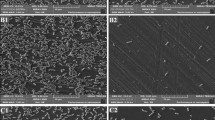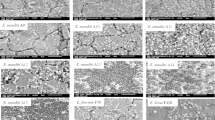Abstract
In this study, we aimed to examine the inhibitory effect of PA003, a Pediococcus acidilactici that produces lactic acid and antimicrobial peptides pediocin, on pathogenic biofilm formation on abiotic surfaces. PA003 and pathogens (Escherichia coli, Salmonella enterica serovar Typhimurium, Staphylococcus aureus and Listeria monocytogenes) were used to evaluate auto-aggregation, hydrophobicity, biofilm formation and biofilm formation inhibition on stainless steel, polyvinyl chloride and glass slides in terms of exclusion, displacement and competition. The results showed the highest auto-aggregation abilities were observed for one of the E. coli strains EAggEC (E58595) and the highest hydrophobic strain was observed with EPEC (E2348/69) (51.9%). The numbers of biofilm cells of E. coli, S. Typhimurium, S. aureus and L. monocytogenes on stainless steel, polyvinyl chloride and glass slide coupons were effectively reduced by approximately 4 log CFU/coupon. These results demonstrate that lactic acid bacteria can be used as an alternative to effectively control the formation of biofilms by food-borne pathogens.





Similar content being viewed by others
References
Giaouris E, Heir E, Hebraud M et al (2014) Attachment and biofilm formation by foodborne bacteria in meat processing environments: causes, implications, role of bacterial interactions and control by alternative novel methods. Meat Sci 97(3):298–309
Gould LH, Demma L, Jones TF et al (2009) Hemolytic uremic syndrome and death in persons with Escherichia coli O157:H7 infection, foodborne diseases active surveillance network sites, 2000–2006. Clin Infect Dis 49(10):1480–1485
Scallan E, Hoekstra RM, Mahon BE et al (2015) An assessment of the human health impact of seven leading foodborne pathogens in the United States using disability adjusted life years. Epidemiol Infect 143(13):1–10
Anand SK, Griffiths MW (2003) Quorum sensing and expression of virulence in Escherichia coli O157:H7. Int J Food Microbiol 85(1–2):1–9
Fux CA, Costerton JW, Stewart PS et al (2005) Survival strategies of infectious biofilms. Trends Microbiol 13(1):34–40
Ryu JH, Beuchat LR (2005) Biofilm formation by Escherichia coli O157:H7 on stainless steel: effect of exopolysaccharide and Curli production on its resistance to chlorine. Appl Environ Microbiol 71(1):247–254
Mah T-FC, O’Toole GA (2001) Mechanisms of biofilm resistance to antimicrobial agents. Trends Microbiol 9(1):34–39
Romling U, Kjelleberg S, Normark S et al (2014) Microbial biofilm formation: a need to act. J Intern Med 276(2):98–110
Simões M, Simões LC, Vieira MJ (2010) A review of current and emergent biofilm control strategies. LWT—Food Sci Technol 43(4):573–583
Jassim SA, Abdulamir AS, Abu Bakar F (2012) Novel phage-based bio-processing of pathogenic Escherichia coli and its biofilms. World J Microbiol Biotechnol 28(1):47–60
Niemira BA, Cooke PH (2010) Escherichia coli O157:H7 biofilm formation on Romaine lettuce and spinach leaf surfaces reduces efficacy of irradiation and sodium hypochlorite washes. J Food Sci 75(5):270–277
Peres CM, Peres C, Hernández-Mendoza A et al (2012) Review on fermented plant materials as carriers and sources of potentially probiotic lactic acid bacteria—with an emphasis on table olives. Trends Food Sci Technol 26(1):31–42
Bautista-Gallego J, Arroyo-López FN, Rantsiou K et al (2013) Screening of lactic acid bacteria isolated from fermented table olives with probiotic potential. Food Res Int 50(1):135–142
Clarke G, Cryan JF, Dinan TG et al (2012) Review article: probiotics for the treatment of irritable bowel syndrome: focus on lactic acid bacteria. Aliment Pharmacol Ther 35(4):403–413
Woo J, Ahn J (2013) Probiotic-mediated competition, exclusion and displacement in biofilm formation by food-borne pathogens. Lett Appl Microbiol 56(4):307–313
Fouladkhah A, Geornaras I, Yang H et al (2013) Lactic acid resistance of Shiga toxin-producing Escherichia coli and multidrug-resistant and susceptible Salmonella Typhimurium and Salmonella Newport in meat homogenate. Food Microbiol 36(2):260–266
Abdulla AA, Abed TA, Saeed A (2014) Adhesion, autoaggregation and hydrophobicity of six Lactobacillus strains. Br Microbiol Res J 4(4):381–391
Bellon-Fontaine M-N, Rault J, Van Oss C (1996) Microbial adhesion to solvents: a novel method to determine the electron-donor/electron-acceptor or Lewis acid-base properties of microbial cells. Colloids Surf B 7(1):47–53
Cherif-Antar A, Moussa-Boudjemâa B, Didouh N et al (2016) Diversity and biofilm-forming capability of bacteria recovered from stainless steel pipes of a milk-processing dairy plant. Dairy Sci Technol 96(1):1–12
Ban GH, Park SH, Kim SO et al (2012) Synergistic effect of steam and lactic acid against Escherichia coli O157:H7, Salmonella Typhimurium, and Listeria monocytogenes biofilms on polyvinyl chloride and stainless steel. Int J Food Microbiol 157(2):218–223
Elramady MG, Aly SS, Rossitto PV et al (2013) Synergistic effects of lactic acid and sodium dodecyl sulfate to decontaminate Escherichia coli O157:H7 on cattle hide sections. Foodborne Pathog Dis 10(7):661–663
Van Houdt R, Michiels CW (2005) Role of bacterial cell surface structures in Escherichia coli biofilm formation. Res Microbiol 156(5–6):626–633
Garnett JA, Martínez-Santos VI, Saldaña Z et al (2012) Structural insights into the biogenesis and biofilm formation by the Escherichia coli common pilus. Proc Natl Acad Sci 109(10):3950–3955
Wang R, Kalchayanand N, Bono JL et al (2012) Dual-serotype biofilm formation by shiga toxin-producing Escherichia coli O157:H7 and O26:H11 strains. Appl Environ Microbiol 78(17):6341–6344
Hood SK, Zottola EA (1997) Adherence to stainless steel by foodborne microorganisms during growth in model food systems. Int J Food Microbiol 37(2):145–153
Sinde E, Carballo J (2000) Attachment of Salmonella spp. and Listeria monocytogenes to stainless steel, rubber and polytetrafluorethylene: the influence of free energy and the effect of commercial sanitizers. Food Microbiol 17(4):439–447
Borucki MK, Peppin JD, White D et al (2003) Variation in biofilm formation among strains of Listeria monocytogenes. Appl Environ Microbiol 69(12):7336–7342
O’Leary D, McCabe EM, McCusker MP et al (2015) Acid environments affect biofilm formation and gene expression in isolates of Salmonella enterica Typhimurium DT104. Int J Food Microbiol 206:7–16
Jeon JG, Rosalen PL, Falsetta ML et al (2011) Natural products in caries research: Current (limited) knowledge, challenges and future perspective. Caries Res 45(3):243–263
Okshevsky M, Regina VR, Meyer RL (2015) Extracellular DNA as a target for biofilm control. Curr Opin Biotechnol 33:73–80
Monteagudo-Mera A, Caro I, Rodriguez-Aparicio LB et al (2011) Characterization of certain bacterial strains for potential use as starter or probiotic cultures in dairy products. J Food Prot 74(8):1379–1386
Kubota H, Senda S, Nomura N et al (2008) Biofilm formation by lactic acid bacteria and resistance to environmental stress. J Biosci Bioeng 106(4):381–386
McMillan A, Dell M, Zellar MP et al (2011) Disruption of urogenital biofilms by lactobacilli. Colloids Surf B Biointerfaces 86(1):58–64
Acknowledgements
Supported by the National Key Technology Research and Development Program of the Ministry of Science and Technology of China (2015BAD16B01); and Tianjin Key Technology Research and Development Support Program (13ZCDNC01900).
Author information
Authors and Affiliations
Corresponding author
Rights and permissions
About this article
Cite this article
Tan, X., Han, Y., Xiao, H. et al. Pediococcus Acidilactici Inhibit Biofilm Formation of Food-Borne Pathogens on Abiotic Surfaces. Trans. Tianjin Univ. 23, 70–77 (2017). https://doi.org/10.1007/s12209-016-0016-z
Received:
Revised:
Accepted:
Published:
Issue Date:
DOI: https://doi.org/10.1007/s12209-016-0016-z




